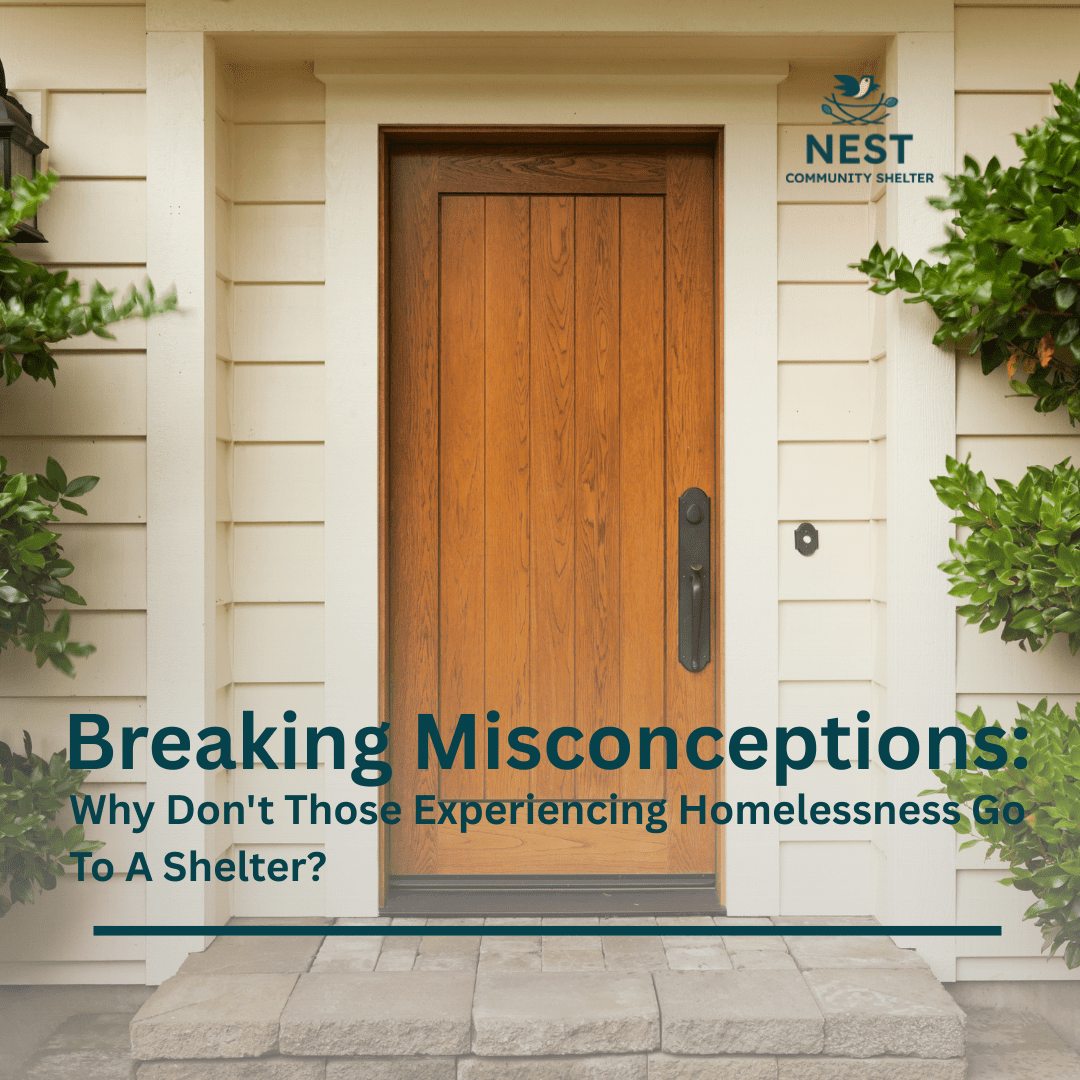
One of the most common questions we hear when discussing our unhoused population is, “Why don’t homeless people just go to a shelter?” It’s a reasonable question from those who haven’t experienced homelessness firsthand. Today, we are going to address the misconception that to solve homelessness, individuals need to be housed in a shelter or other supporting facility. Often, the barriers that individuals experiencing homelessness face are not easy to overcome. This article is a continuation of our series on misconceptions surrounding homelessness.
Barriers that Keep Individuals Away and Make Choice Complex:
While our shelter provides a safe place for many to rest and eat, we recognize that several factors may influence someone’s decision to remain unsheltered. Below, we have compiled a list of the most common barriers we see within our community to receiving support services and being sheltered at Nest Community Shelter.
The Stigma of Shelter Use:
The stigma associated with homelessness and shelter use presents a powerful psychological barrier. Many people feel profound shame about their housing situation, leading them to hide their homelessness from friends, family, and even service providers. This stigma can present in several ways:
- Fear of judgment: Many individuals worry about being stereotyped as “lazy,” “addicted,” or “mentally ill” if it becomes known that they are utilizing services from a homeless shelter. Or that their homelessness is somehow a character judgment of them as a person.
- Loss of dignity: The perception that accepting shelter services means admitting failure or giving up independence.
- Social isolation: Research shows that people experiencing homelessness often withdraw from their support network for various reasons.
Our mission at Nest Community Shelter is to connect our guests back to their communities. We work diligently to create an environment of respect and dignity, but we understand that the societal stigma around homelessness remains a significant obstacle for many. By reconnecting our guests, we break these barriers one case at a time, one guest at a time.
A Beloved Companion, Pets:
This is perhaps one of our most common barriers, that we cannot accommodate pets. Imagine losing your home, car, and possibly your job, yet you’ve managed to keep your pet. The stigma of homelessness has caused you to withdraw from your support circle and access the needed services. Now, it’s you and your pet, and your pet does not look at you as experiencing homelessness, but simply the human companion they’ve always loved. Now, you finally decide to seek out shelter, only find out that your pet cannot come into the shelter.
While this story may seem far-fetched, it isn’t. We encounter this a lot. This is heartbreaking for us as shelter providers and for our guests. This is an extremely common barrier to receiving services across the United States. While we work with potential guests to find a solution to having a pet fostered, more often than not, this remains a significant stumbling block for potential guests.
Safety & Storage Concerns
For many who have experienced trauma, crowded communal living spaces can feel unsafe. Concerns about personal safety, privacy, and protection of belongings are valid considerations in shelter environments. This is especially true for vulnerable populations, including LGBTQ+ youth, domestic violence survivors, and those with past traumatic experiences.
At Nest Community Shelter, our open room accommodations and site monitors on both our men’s and women’s floors do help alleviate some safety concerns. However, our shelter can be challenging for those sensitive to loud noises or large crowds. We provide our guests with a plastic tote to store their things for the evening each night. This can be very challenging for our guests who may have more belongings with them. As a smaller shelter, we do not have the ability to allow guests to bring in all of their belongings with them. This poses a real challenge for some of our guests. If you’ve lost everything and your belongings are all that you have left, and now you’re being asked not to bring them with you, this poses a significant barrier.
Restrictive Rules and Schedules
While structure is necessary for communal living, some shelters have rules that don’t accommodate the complex realities of people’s lives. Strict entry and exit times may conflict with work schedules, especially for those working evening or overnight shifts.
At Nest Community Shelter, our doors open in the evening and once guests have checked in for the night (signed in, have a temperature check, evaluation for drugs and or alcohol use) they are not able to leave the shelter for the night. This is a safety precaution for the good of all of our guests. Some find this rule to be too strict, but we must think of the safety of all of our guests.
Working Beyond the Barriers:
Despite these challenges, we remain a vital resource in addressing homelessness in La Porte County. Shelter services like ours provide far more than just a bed for the night, at Nest we strive to provide:
- Immediate safety from the elements, violence, and exploitation
- Access to healthcare, through connection to support services, including mental health and substance use treatment.
- Case management to navigate complex social service systems.
- Housing support services to find more permanent solutions
- Community and support to counter the isolation of homelessness.
At Nest Community Shelter, we recognize these common yet complex barriers and continuously work to make our services more accessible and effective for everyone experiencing homelessness in our community. While we have addressed a few of the most common barriers, the reasons why individuals may not want to seek our services are just as complex as the individuals themselves. We hope that by sharing some of these common barriers, the misconception that simply choosing to be sheltered solves the issue, when in fact, for some, it creates more problems. Our guests are complex and often the issues and decisions they’re faced with are not as simple as choosing to be housed.
How You Can Help
We hope that this article helps build an understanding of the illusion of choice for some and truly heartbreaking choices. By learning about this misconception, you can be part of creating more compassionate solutions:
- Challenge stigma by speaking thoughtfully about homelessness and recognizing that it could happen to anyone.
- Volunteer your time and talents at local shelters and support services.
- Support organizations working on innovative housing solutions in our community.
- Advocate for policies that increase affordable housing and support services at the state, federal, and local levels of legislation.
By understanding the real barriers people face, we can work together toward meaningful solutions that genuinely address the needs of our neighbors experiencing homelessness.



